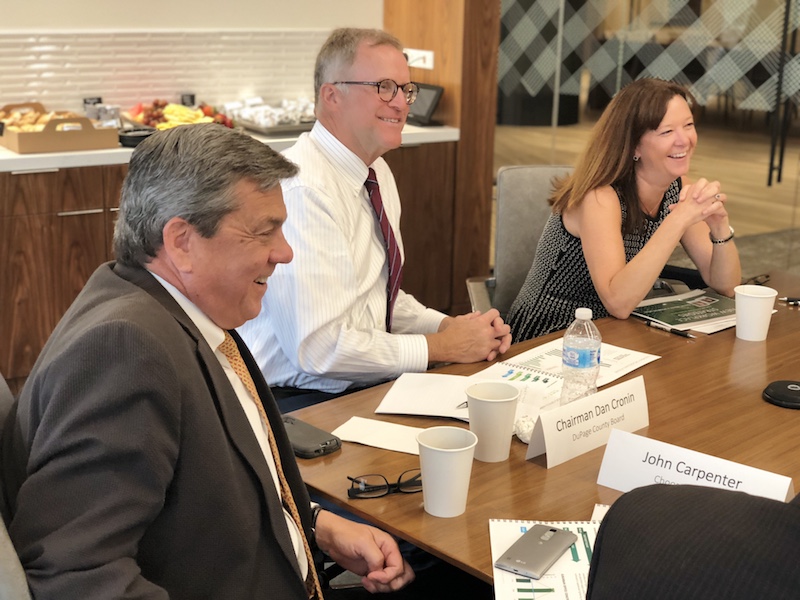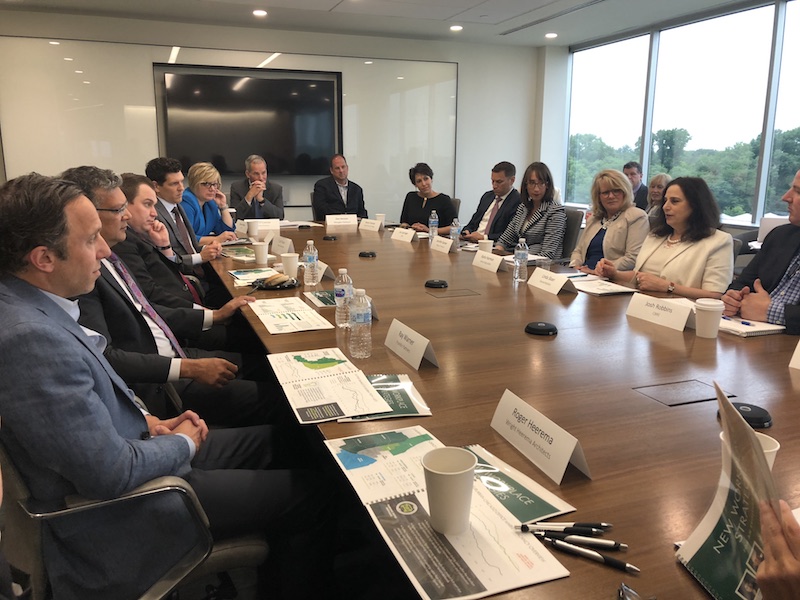Technology & innovation in the office space, and how to stay competitive in today’s marketplace
Leaders in real estate and development gathered on Thursday, June 20 at a breakfast hosted by Choose DuPage and DuPage County Board Chairman, Dan Cronin for a lively discussion about how changing technology and innovation impact businesses’ office space needs. Business representatives around the table talked about the many ways DuPage County workplaces are evolving to embrace these “offices of the future.” The discussion was led by Paul O’Connor of Hamilton Partners.
“DuPage County’s real estate market has evolved tremendously in recent years,” said Chairman Cronin. “In order to continue driving economic development, we need to ensure we are meeting the needs of today’s market. Ultimately, we hope that by having collaborative discussions like this, we can develop creative solutions to remain competitive.”
The discussion was largely focused on: trends in office spaces and meeting the needs of today’s workforce; the competitive landscape, and how to remain an attractive market; and creative solutions to solving transportation needs.
Trends in Office Spaces & Meeting the Needs of Today’s Workforce
Diana Riekse of CBRE shared CBRE’s recent report: New Workplace Strategies for an Evolving Workforce. Key highlights of the report include:
- 79% of businesses say space use is a top priority.
- 86% of corporate real estate executives say that tenants are adapting the workplace for more collaboration and less cost.
- Today, unassigned seating makes up 51% of workplaces. In three years, it is expected to reach almost 75%.
- Amenities are the #1 thing employees care about in their workplace.
- 64% of tenants are seeking amenities like hospitality and concierge services.
- The top amenity that employees want today (79%) are bike racks.
Linda Sloan of Shared Use Mobility Center said, “I work in a shared workspace with many millennials. As I’ve gotten to know these younger professionals, I’ve found that they work very hard, but their whole world is different than the one I started in – a conventional office space with a hierarchy of people. Millennials are very entrepreneurial, they like flat work structures with opportunity for collaboration, and open work spaces.”
Ray Warner of Franklin Partners, who is re-developing the former OfficeMax headquarters in Naperville, said, “We feel that by raising the bar in the amenity class, it will give tenants an alternative asset to consider when choosing the location of their corporate headquarters. What has been missing [in this market] are the things that attract millennials and companies that are trying to re-brand their vision.”
The Competitive Landscape & How to Remain an Attractive Market
The group discussed the need for owners to re-invest in their buildings in order to continue attracting tenants to this market. “I think if there is one area I would creatively focus on, it is incentivizing tenants to sign longer-term leases. That can be hard, but that is what can transform an asset,” said Dan Deuter, CBRE. “When tenants are willing to make long-term commitments, the level of investment into the building is higher.”
They agreed that nationally, there is a perception among investors that companies are moving away from the suburbs to go downtown. Dan Hession of Morgan Harbor shared an alternative perspective, “Not everyone is going downtown. We just completed the new HubGroup headquarters in Oak Brook and they wanted to stay in DuPage County. They have a long history in DuPage, and this is where their workforce is located.”
The consensus of the group was—in order to remain an attractive market, DuPage County needs creative solutions and collaboration.
Creative Solutions to Solving Transportation Needs
According to CBRE’s Chicago Suburban Office Market Overview, parking ratios have become an increased sticking point within the suburban market as tenants continue to seek improved efficiency and collaboration through historically high-density levels. The higher market vacancy figures among suburban product is in part due to the lack of necessary parking to meet increased tenant demands.
More and more, young professionals are seeking alternatives to driving to work, and the suburban office market needs to find solutions to the first-mile & last-mile commute problem. This occurs when distances between transit stations and centers of employment are too great to walk.
“You need to think very regionally—both within the County and outside its borders, about your network of transportation and how to fill those gaps,” said Linda Sloan.
John Carpenter, President & CEO of Choose DuPage said, “we need transportation solutions to be accessible and simple. This means incorporating low (or no) -tech solutions like walking, mid-tech solutions like biking, and high-tech solutions like electric vehicles.”
Diana Riekse concluded the meeting by saying “Not only our buildings, but also our communities, need to have the amenities people want today. And the only way for this to come to fruition is through collaboration between public- and private-sector leaders.”



